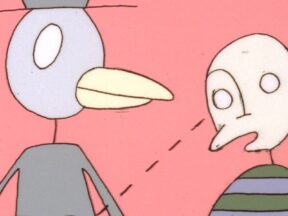

Sheridan College Alumni Discuss Their Time At Canada’s Most Famous Animation School
In our ongoing series on exceptional international animation schools, we take a look at one of the most famous animation schools in the world: Canada’s Sheridan College.
Nestled in the small, conservative town of Oakville, Ontario (about a 25-mile drive from Toronto), Sheridan boasts the world’s oldest animation department. Nelvana co-founder Michael Hirsh deemed Sheridan “the Harvard of animation.” Hyperbole? Perhaps, but an argument can be made that no animation school outside of Calarts has been as influential and successful as Sheridan.
Just take a look at this list of alumni: Chris Williams (director, The Sea Beast), Domee Shi (director, Turning Red), Danny Antonucci (creator, Ed, Edd n Eddy), John Kricfalusi (creator, The Ren & Stimpy Show), Alan Barillaro (director, Piper), Nick Cross (art director, Over the Garden Wall; director, The Waif of Persephone), Dean DeBlois (director, How to Train Your Dragon), Steve “Spaz” Williams (cg animator, Jurassic Park), Nik Ranieri (veteran Walt Disney Animation Studios animator), Sheldon Cohen (director, The Sweater), Jon Klassen (illustrator, I Want My Hat Back), Jeff Lemire (author, Sweet Tooth), Frank Falcone (head of Guru Animation), Glenn McQueen (supervising character animator at Pixar), Michel Gagné (effects supervisor, The Iron Giant), Charles Bonafacio (animation supervisor, Klaus), just to name a few.
Sheridan College was founded in 1967. The animation program opened a year later, in 1968, and grew into a three-year diploma in animation. In 1978, the department started a post-graduate program (the International Summer School of Animation) and in 1981, that was turned into a computer animation, digital creature, and vfx graduate certificate. In 2004, the length of the study was changed once again, this time to the internationally recognized Honors Bachelor of Animation four-year degree program.
How the Program Works
While the areas of focus have changed since 1968, the goal of the animation department remains the same. “We are focused on ensuring our students have high competency in three core areas: the art of animation, leadership and interpersonal skills, and technical affinity with the latest technologies and software used in studios,” says Theresa Scandiffio, associate dean, animation and game design. “These three goals ensure our learners thrive in their career in the modern world of animation.”
In terms of specifics, the Honors Bachelor of Animation is a four-year program with an internship between years three and four. If you’re Canadian, the domestic tuition fee is $4,934 (all following figures are in Canadian currency) per term. If you’re from outside of Canada, the rate jumps to $15,091 per term. The Honors program accepts 150 students from about 1,400 applicants, and on average, 135 students graduate annually. There are ten full-time faculty, 23 part-timers, and another 17 mentors.
In terms of the courses that are offered, Scandiffio notes, “All our programs and certificates focus on experiential learning in a collaborative studio environment.”
The Honors Bachelor of Animation program is divided into five streams: animation, story, layout, life drawing, and digital. Animation, story, layout, and life drawing are taught during the first three years. The digital stream splits off in year four, when students have a chance to dive deeper into either 2d or 3d tools. In the third year, students also have the option of focusing on stop motion, concept art, 3d modeling, 2d rigging, 3d rigging, or Final Frame. During the fourth year, the focus shifts to an individual thesis project. Students are also assigned an industry professional or mentor to guide them during their final year.
Given Sheridan’s industry aims, it’s no surprise that they have a strong relationship with animation studios around the globe.
“We lead several professional advisory committees (PACs) that advise us multiple times a year on the vision and goals of our program,” says Scandiffio. “The feedback from these councils is vital to ensuring our curriculum and technology, as well as work-integrated learning opportunities such as cooperative internships, are world-class.” Additionally, the honors program offers co-op opportunities. “We offer 420 hours of a co-op internship where students work in the industry during the summer between their third and fourth years,” explains Scandiffio. “Upon graduation, we hold annual graduation industry events for students to get an opportunity to showcase their work and network with future employers; many of the studios provide awards for the top student work.”
Students of animation do not only work with the industry, but often collaborate with other departments and schools. For example, the music composition program at the University of Toronto allows students to compose music for Sheridan animation film projects. “We also have strong internal partnerships where animation students collaborate closely with game design or musical theatre students on their final thesis projects,” Scandiffio says.
Student Perspectives
Why Sheridan?
“It was the first animation school I was aware of as a kid,” says Brent Smith (a 2014 graduate). “A talented schoolmate a few years ahead of me in high school was accepted there, and it was obvious this was the right path for him. I took art fundamentals there when I finished high school, and despite it being a very significant year in my life as a whole, I enjoyed the experience of the school itself. I’d studied animation elsewhere, but when the opportunity arose for me to update and upgrade my animation skills, Sheridan was the place I needed to be.”
“I chose Sheridan since it had a really great reputation,” adds Noam Sussman (2012). “It was the best in Canada and in the top 10 worldwide back in 2007. Other art schools in the area either didn’t have an animation program or their reputation wasn’t as good, but I think they’re catching up now. Another consideration was that Sheridan offered a bachelor’s degree, which supposedly makes it easier to work in the States.”
“I failed the first time I applied before getting in on my second attempt,” admits Colin Searle (2016). “I was local, so that alone made it the best option. There were also several online polls floating around at the time showing Sheridan as either the top or one of the top schools for animation specifically. I’ve met many previous Sheridan alumni who graduated years before me and who have either amazing or horrifying stories to tell about their time in the animation program; it seems to depend on the year. Some haven’t worked in the entertainment field at all after Sheridan; others have been working in the industry since graduation, like myself. It comes down to the person and their investment, I think.”
Expectations Met?
“The tuition at the time was already fairly high,” says Searle, “and so I expected a reasonable amount of hands-on guidance from whoever was teaching the various courses. What I noticed is that a lot of the classes were even larger than the overstretched classes I had in high school (20-30+ students per professor, per class), which made it a lot harder for them to focus on any one student or even small groups. The program felt very bloated, with too many students and too few professors and support staff. That said, a few profs were willing to go above and beyond with extra office hours and extra support for those students willing to engage further with them, which I very much appreciated and took them up on (as did a few others).”
Sussman is more positive about his overall experience: “In many ways, it not only matched but exceeded my expectations. It was great being around talented people, and I think we learned a lot from each other. I think Sheridan’s industry day event is also extremely valuable. I think what was missing was a bit of guidance on what to expect from the industry in terms of the different routes that are available. It seems like the go-to is for everyone to enter the tv and feature industry and studio lifestyle without ever learning about the possibilities of freelance work, commercial work, independent filmmaking, etc.”
Highlights
“The most valuable thing I learned at Sheridan is that no one is going to hand you the skills you need to survive for free (not without asking first, anyway),” says Searle. “No one is going to reach out with anything on a silver platter; you have to be hyper-engaged and constantly on the ball. No one will be there to save you if the work you bring to industry day is terrible. Four years isn’t a lot to go from a borderline non-artist state to a working professional (in my case, when I compare my skills now to shortly before my first year, it’s an entire world of difference). Every extra life-drawing class and redone assignment really does count. No professor is going to force you to come to their office hours to ask questions, get work reviewed, or just shoot the shit, you have to do it yourself.”
Improvements?
“The group film was a pain in the ass,” says Sussman. “I understand why they have it, but I would’ve preferred to make more solo films without a group. I think the Calarts way seems more interesting, with a bigger focus on your own individual development as an artist.”
“Layout needs to make a return,” says Searle. “Students need to be given a full traditional layout education (combined with storyboarding, not separately) to better prepare them for working in production, even 3d ones. I’ve now seen students coming into the industry with no perspective drawing skills, an inability to handle environment drawing or placing characters within environments (even with 3d reference), and many other things that traditional layout education would give them, and they’re now stuck without.”
“I can’t think of anything that was missing offhand,” says Brent Smith. “It might have been helpful to have some guidance as to where my aptitude would point me in a studio position. We were taught the entire pipeline process of what we needed to create a short film, from start to finish. I wasn’t sure where I was best suited for my job hunt; some of my classmates were obvious modelers, animators, and riggers. I applied to a variety of positions before I was hired at my first studio.”
Ready for the Working World?
“I personally left with relatively high preparedness for the industry, even if it didn’t quite feel like it at the time,” Searle concludes. “I had over a dozen job offers before my fourth year was officially over, with half of them being certain with contracts on the table. I ended up taking an offer directly from an animation studio head who had come to review portfolios two weeks before industry day and called me with an open job offer the next morning. The lesson from that story is to go to any and all portfolio reviews on offer, as you never know what might happen. Overall, when taking everything into account, my time in animation at Sheridan was a success, maybe even a blast. Even with all the issues, all the BS, and the things about it I’d change if I could, I was able to mold it into the kind of education I needed for this industry.”
Pictured at top: Pixar’s Bao directed by Sheridan alum Domee Shi.
The original tuition prices in this article were inacurate, and have updated to the 2022-2023 academic year’s totals.

.png)


